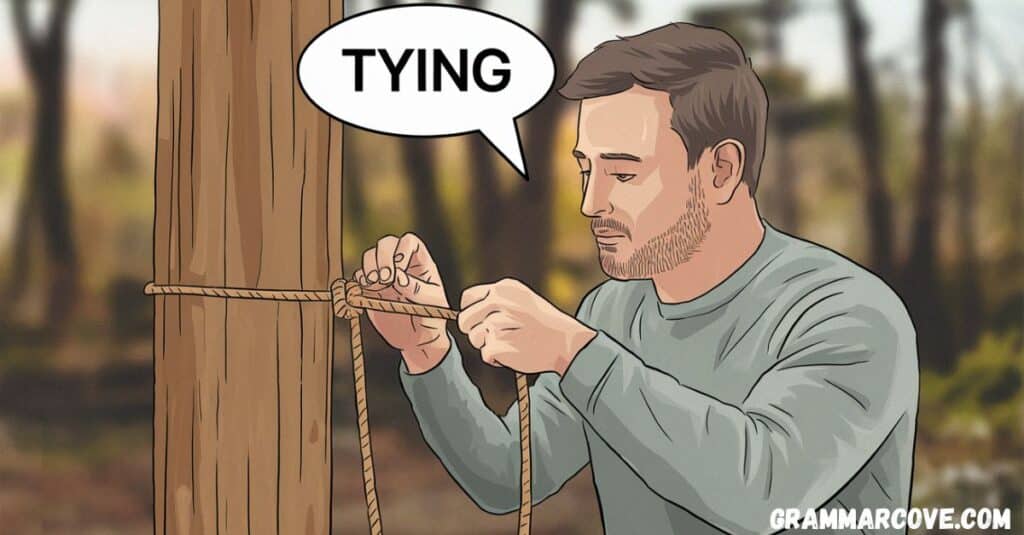When it comes to the English language, spelling can be tricky. We often stumble upon words that sound the same but have different spellings. One such example is tying vs. tieing. If you’ve ever wondered “Is it tying or tieing?”, you’re not alone. While both forms might look similar, they aren’t always interchangeable.
This article will guide you through the nuances of these two forms, helping you understand when and where each should be used.
Tying or Tieing: What’s the Difference?
Before we dive into tying vs. tieing, let’s first explore what each word means. Both tying and tieing are derived from the verb tie, but the key difference lies in their spelling and usage.
- Tying is the more commonly used and correct spelling in modern English. It refers to the act of binding something with a knot or loop.
- Example: She was tying her shoes when the bell rang.
- Tieing, on the other hand, is considered an older variant of the word and has largely fallen out of use. However, it still appears occasionally, mostly in historical or poetic contexts.
- Example: He was tieing the rope to the mast of the ship, preparing for the journey.
The Correct Spelling: Tying
The spelling tying is the correct form used in most situations. It’s important to remember that tying is the gerund or present participle form of the verb tie. The gerund form is used to express an ongoing action or a state of being.
Examples of Tying in Everyday Usage:
- Tying your shoes: When you bend down to tie your shoes, you’re performing the action of tying.
- Tying a knot: In sailing, tying a knot correctly can be the difference between life and death.
- Tying a ribbon: Many people enjoy tying a ribbon around a gift box as a final touch.
Tieing as an Older Spelling Variant
Historically, tieing was considered an acceptable spelling. Over time, however, tying became more widely accepted, and tieing started to fall out of favor. In contemporary English, tieing is largely seen as a misspelling. It still appears occasionally in older texts, literature, and historical documents.
Example of Tieing in Older Literature:
- “He was tieing the ropes with great care, ensuring the ship would not drift away during the storm.” (This example would likely be found in a historical novel or a piece written before the 20th century.)

Tying vs. Tieing: The Grammar Rules
Understanding the grammar rules behind tying and tieing can help you avoid mistakes in your writing. As mentioned, tying is the preferred spelling in modern English. Tieing, while still recognized, is considered outdated.
Here’s a quick overview:
| Rule | Tying | Tieing |
|---|---|---|
| Current usage | Correct | Outdated |
| Grammar form | Gerund/Present Participle | Gerund/Present Participle |
| Meaning | The act of tying or fastening | Same meaning, but now rare |
| Commonness | Very common in modern writing | Rare in modern usage |
Tying vs. Tieing: Context and Proper Usage
Now let’s dive into how these two forms play out in real-life scenarios. Consider the following examples, where tying is the preferred form:
Example 1: Email to a Friend
Subject: Need Help Tying the Knots!
Hey Sarah,
I hope you’re doing well! I’m working on a new DIY project, and I need your expertise. I’m trying to figure out the best way of tying these decorative knots, but I can’t seem to get it right. Do you have any tips or tutorials?
Thanks in advance!
Best,
Emma
In this email, the act of tying knots is clearly the ongoing action. Using tieing here would make the sentence feel old-fashioned and grammatically incorrect.
Example 2: Casual Conversation
Mark: “I spent hours tying up the garden fence.” Nina: “I know the feeling. I was tying ribbons around all the chairs for my wedding last week!”
Both Mark and Nina are talking about the present participle form of tie, and tying is the proper spelling.
Example 3: Historical Fiction Excerpt
“The sailor was tieing the ropes to secure the ship to the dock, but the storm was approaching rapidly.”
In this case, the word tieing fits the historical context, reflecting language from older times.
Common Misspellings of Tying
Since tying and tieing are so similar, people often confuse the two. However, tieing is frequently misused in modern writing, despite being incorrect. Other common misspellings include:
- Tyeing (a non-existent form)
- Tyingg (double “g”)
When in doubt, remember: tying is always correct in contemporary writing.
Tying Definition and Usage
To understand when and how to use tying, it’s important to know its definition. The verb tie means to fasten or secure something with a knot, string, or other means of binding.
Tying is the process of performing this action.
Example of Proper Usage in a Sentence:
- “He was tying the ribbon into a bow when the doorbell rang.”
- “After tying the rope securely, she climbed the cliff with confidence.”
Gerund Forms of Tie
The gerund form of a verb is often used to express an ongoing action, as seen in tying. For example, in the sentence “I enjoy tying my shoes in the morning,” the action of tying is an ongoing one that happens repeatedly.

FAQ on Tying vs. Tieing
1. Is it tying or tieing?
- Tying is the correct spelling. Tieing is outdated.
2. How to spell tieing?
- The correct form is tying.
3. Why do people still use tieing?
- Some people may use tieing out of habit or because they’ve encountered older texts that use it. However, tying is now the widely accepted and correct form.
4. When should I use tieing?
- You should avoid using tieing in modern writing unless you are quoting something from an older text or writing in a poetic, historical, or archaic style.
5. What is the correct spelling of tying?
- The correct spelling is tying.
Tying Meaning and Context
Let’s finish by understanding the broader meaning of tying and the contexts in which it can be used.
- Tying refers to the act of fastening, binding, or joining something together with a knot or a similar method. This can apply to shoes, ropes, ribbons, or even abstract concepts (e.g., tying loose ends in a project).
- Tieing, while still recognized in older English, is rarely used in modern contexts and should generally be avoided.
Conclusion: Tying or Tieing?
In summary, tying is the modern, widely accepted form. When you’re writing, remember that tying refers to the act of fastening something with a knot, loop, or bond. Tieing, though once common, is now largely outdated. Whether you’re writing an email, drafting a novel, or having a casual conversation, stick with tying for accuracy and clarity.
Now that you’re equipped with the knowledge of tying vs. tieing, you can confidently use the correct form in your writing. The next time you find yourself questioning “How to spell tieing?”, you’ll know that tying is the proper choice!

Steel Morgan is an experienced blogger passionate about language and writing. On Grammarcove. he shares his expertise in grammar, punctuation, and effective communication, making complex rules simple and accessible for readers. With a knack for clear explanations and engaging content, Steel aims to help others master the art of language.







